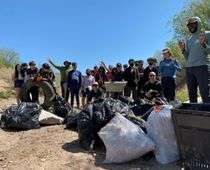Adapted with permission from Arizona Project WET’s Aqua STEM Program, this 10-lesson Rainwater Harvesting unit was localized for the Santa Fe region by SFWA’s Director of Education, Julie Hasty. The curriculum—which is designed to meet middle school and high school science standards—engages students in the Engineering Design Process through hands-on exploration of rainwater capture and green stormwater infrastructure. By connecting science, sustainability, and real-world problem-solving, students learn the value of water conservation and how to design systems that support climate resilience and help protect the long-term health of the Santa Fe watershed.
Contact Julie for any curriculum-related questions.
What’s cool about rainwater harvesting in a warming world?
Climate Change in New Mexico is causing an increase in average temperatures, less precipitation in the form of snowpack, and an increase in extreme storm events during warmer times of year with more evaporation leading to increased aridification.
Water in the form of precipitation moves through the watershed by flowing over surfaces as runoff, gathering quantity and momentum as it is pulled by gravity. When flowing over impermeable or semi-impermeable surfaces, water will eventually leave the watershed through the arroyo system. When allowed to slow and spread out over permeable surfaces, the water will infiltrate into the soil to be taken up and used by plants or move down into the groundwater system, staying within the watershed.
With the Rainwater Harvesting Curriculum, students use the engineering design process to design rainwater harvesting systems that create green stormwater infrastructure (GSI) allowing runoff to infiltrate into the soil, cool the space, and support native plants. Students take a watershed approach to study their school yard to determine the best placement and plan for their system. With the knowledge they acquire, they will understand clearly how to build resiliency when responding to local climate threats of increased temperatures, extreme storm events, and persistent drought.
Click above to read the Rainwater Harvesting Unit Guide
Click here to read the Unit Guide or select a Lesson below!
Lessons are estimated to take one class period, except for Lesson 9 and Lesson 10, which are designed to cover two class periods. Actual time may vary.























